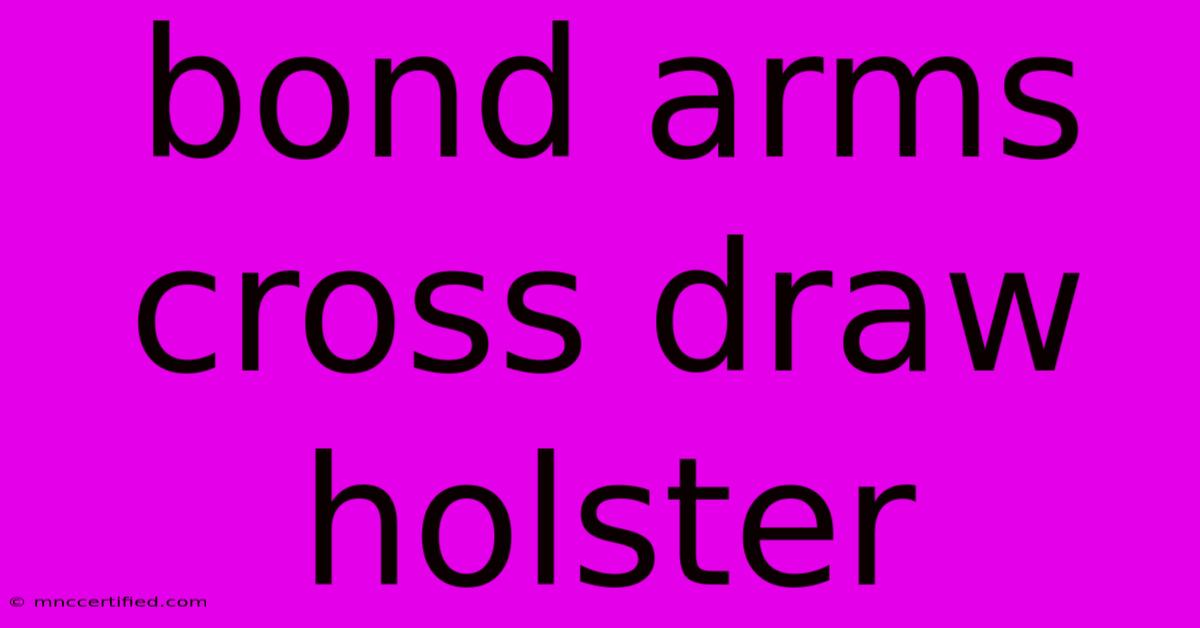Bond Arms Cross Draw Holster

Table of Contents
Bond Arms Cross Draw Holster: A Comprehensive Guide
Finding the right holster is crucial for concealed carry, and for Bond Arms pistols, the cross draw style presents unique advantages and considerations. This guide dives deep into Bond Arms cross draw holsters, exploring their benefits, drawbacks, and how to choose the perfect one for your needs.
Understanding the Bond Arms Pistol and Cross Draw Holsters
Bond Arms pistols, known for their compact size and unique design, are popular choices for backup guns or concealed carry. Their small stature, however, necessitates a holster designed for efficient access and secure retention. A cross draw holster offers a distinct advantage in this regard, allowing for a quick draw from a less-obvious position. Instead of drawing from the strong-side hip, a cross draw holster is worn on the opposite side of the body.
Advantages of a Bond Arms Cross Draw Holster
- Concealment: The cross draw position often allows for better concealment, especially with smaller Bond Arms models like the Backup pistol. The holster is less visible and less likely to print through clothing.
- Quick Draw (Potentially): A well-designed cross draw holster can facilitate a rapid draw, although this requires practice and adaptation. The motion is different from a strong-side draw, so training is essential.
- Accessibility: A cross draw holster can be advantageous in situations where accessing a strong-side holster is difficult, such as driving or navigating tight spaces.
Disadvantages of a Bond Arms Cross Draw Holster
- Learning Curve: The cross-draw technique requires dedicated practice and training to master. It's not as intuitive as a strong-side draw and can take significant time to develop muscle memory.
- Draw Stroke: The cross-draw motion can be awkward or slow if the holster isn't properly fitted or if the user isn't adequately trained. Proper body mechanics are critical.
- Potential for Accidental Discharge: Incorrect holstering or improper handling increases the risk of an accidental discharge, making safety training paramount.
- Comfort: Some users find cross draw holsters less comfortable than strong-side holsters, particularly during prolonged wear.
Choosing the Right Bond Arms Cross Draw Holster
Selecting the optimal holster depends on several factors:
1. Material:
- Leather: Offers excellent breathability and molds to the body over time, providing a comfortable and customized fit. However, leather requires more maintenance.
- Kydex: A durable and low-maintenance polymer that provides excellent retention and protection. Kydex holsters are known for their rigidity and precision fit.
- Hybrid Holsters: Combine the benefits of both leather and Kydex, often using Kydex for the retention shell and leather for comfort.
2. Retention:
Strong retention is vital for safety. Look for a holster with features like a secure snap, thumb break, or other retention mechanisms designed to prevent accidental discharge. Never compromise on retention.
3. Fit:
The holster must fit your specific Bond Arms model precisely. A poorly fitted holster can lead to difficulties in drawing, re-holstering, or even accidental discharge.
4. Comfort and Carry Position:
Experiment with different carry positions and holster designs to find the most comfortable and concealable option for you. Consider factors like your body type and clothing choices.
5. Accessibility and Draw Speed:
Consider how easy it is to draw the firearm from the holster. Practice your draw stroke extensively. A smooth, efficient draw is crucial, but safety should always be the priority.
Finding Reputable Bond Arms Cross Draw Holster Manufacturers
Several reputable manufacturers specialize in Bond Arms holsters. Research and read reviews before purchasing. Look for brands known for quality materials, craftsmanship, and customer service.
Conclusion: Safety First
While a Bond Arms cross draw holster offers unique advantages, it's crucial to prioritize safety. Thorough training and practice are essential to ensure safe and efficient use. Invest in a high-quality holster from a reputable manufacturer and always practice responsible gun handling. Remember, a poorly fitted or poorly designed holster can be extremely dangerous. Prioritize safety above all else.

Thank you for visiting our website wich cover about Bond Arms Cross Draw Holster. We hope the information provided has been useful to you. Feel free to contact us if you have any questions or need further assistance. See you next time and dont miss to bookmark.
Featured Posts
-
Best Ps 5 Deals This Black Friday
Nov 30, 2024
-
How To Break Super Glue Bond
Nov 30, 2024
-
Deion Sanders With Sons At Cu
Nov 30, 2024
-
Haigh Resigns Transport Secretary Admits Phone Use
Nov 30, 2024
-
Bond Bleecker Street Perfume
Nov 30, 2024